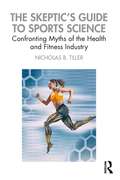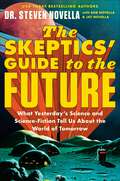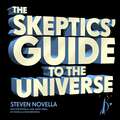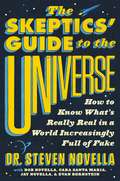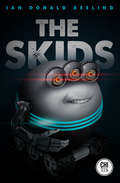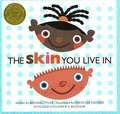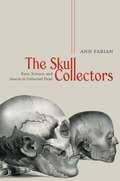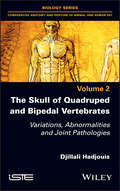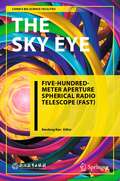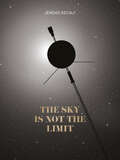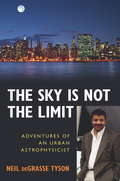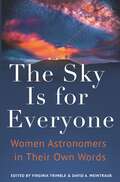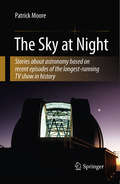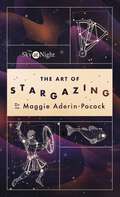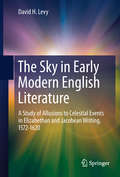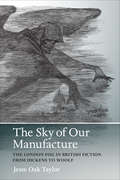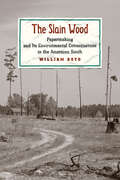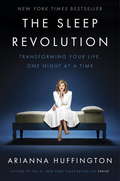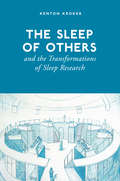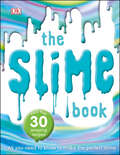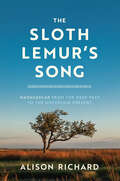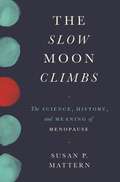- Table View
- List View
The Skeptic's Guide to Sports Science: Confronting Myths of the Health and Fitness Industry
by Nicholas B. TillerThe global health and fitness industry is worth an estimated $4 trillion. We spend $90 billion each year on health club memberships and $100 billion each year on dietary supplements. In such an industrial climate, lax regulations on the products we are sold (supplements, fad-diets, training programs, gadgets, and garments) result in marketing campaigns underpinned by strong claims and weak evidence. Moreover, our critical faculties are ill-suited to a culture characterized by fake news, social media, misinformation, and bad science. We have become walking, talking prey to 21st-Century Snake Oil salesmen. In The Skeptic’s Guide to Sports Science, Nicholas B. Tiller confronts the claims behind the products and the evidence behind the claims. The author discusses what might be wrong with the sales pitch, the glossy magazine advert, and the celebrity endorsements that our heuristically-wired brains find so innately attractive. Tiller also explores the appeal of the one quick fix, the fallacious arguments that are a mainstay of product advertising, and the critical steps we must take in retraining our minds to navigate the pitfalls of the modern consumerist culture. This informative and accessible volume pulls no punches in scrutinizing the plausibility of, and evidence for, the most popular sports products and practices on the market. Readers are encouraged to confront their conceptualizations of the industry and, by the book’s end, they will have acquired the skills necessary to independently judge the effectiveness of sports-related products. This treatise on the commercialization of science in sport and exercise is a must-read for exercisers, athletes, students, and practitioners who hope to retain their intellectual integrity in a lucrative health and fitness industry that is spiraling out-of-control.
The Skeptical Environmentalist: Measuring the Real State of the World
by Bjørn LomborgThe Skeptical Environmentalist challenges widely held beliefs that the environmental situation is getting worse and worse and is critical of the way in which many environmental organizations make selective and misleading use of the scientific evidence. Using the best available statistical information from internationally recognized research institutes, it systematically examines a range of major environmental problems that feature prominently in headline news across the world.
The Skeptics' Guide to the Future: What Yesterday's Science and Science Fiction Tell Us About the World of Tomorrow
by Dr. Steven NovellaFrom the bestselling authors and hosts of "The Skeptics' Guide to the Universe," a high-tech roadmap of the future in their beloved voice, cracking open the follies of futurists past and how technology will profoundly change our world, redefining what it means to be human.Our predictions of the future are a wild fantasy, inextricably linked to our present hopes and fears, biases and ignorance. Whether they be the outlandish leaps predicted in the 1920s, like multi-purpose utility belts with climate control capabilities and planes the size of luxury cruise ships, or the forecasts of the &‘60s, which didn&’t anticipate the sexual revolution or women&’s liberation, the path to the present is littered with failed predictions and incorrect estimations. The best we can do is try to absorb the lessons from futurism's checkered past, perhaps learning to do a little better.In THE SKEPTICS' GUIDE TO THE FUTURE, Steven Novella and his co-authors build upon the work of futurists of the past by examining what they got right, what they got wrong, and how they came to those conclusions. By exploring the pitfalls of each era, they give their own speculations about the distant future, transformed by unbelievable technology ranging from genetic manipulation to artificial intelligence and quantum computing. Applying their trademark skepticism, they carefully extrapolate upon each scientific development, leaving no stone unturned as they lay out a vision for the future.
The Skeptics' Guide to the Universe: How To Know What's Really Real in a World Increasingly Full of Fake
by Steven Novella'A fantastic compendium of skeptical thinking and the perfect primer for anyone who wants to separate fact from fiction.' Richard Wiseman, author 59 Seconds'Thorough, informative, and enlightening... If this book does not become required reading for us all, we may well see modern civilization unravel before our eyes.' Neil deGrasse Tyson, author of Astrophysics for People in a HurryIn this tie-in to their popular 'The Skeptics Guide to the Universe' podcast, Steven Novella, along with 'Skeptical Rogues' Bob Novella, Cara Santa Maria, Jay Novella and Evan Bernstein explain the tenets of skeptical thinking and debunk some of the biggest scientific myths, fallacies and conspiracy theories (anti-vaccines, homeopathy, UFO sightings, and many more.) They'll help us try to make sense of what seems like an increasingly crazy world using powerful tools like science and philosophy. The Skeptics' Guide to the Universe is your guide through this maze of modern life. It covers essential critical thinking skills, as well as giving insight into how your brain works and how to avoid common pitfalls in thinking. They discuss the difference between science and pseudoscience, how to recognize common science news tropes, how to discuss conspiracy theories with that crazy colleague of yours, and how to apply all of this to everyday life.As fascinating as it is entertaining, this page turner is your essential guide to seeing through the fake news and media manipulation in our increasingly confusing world.
The Skeptics' Guide to the Universe: How To Know What's Really Real in a World Increasingly Full of Fake
by Steven Novella'A fantastic compendium of skeptical thinking and the perfect primer for anyone who wants to separate fact from fiction.' Richard Wiseman, author 59 Seconds'Thorough, informative, and enlightening... If this book does not become required reading for us all, we may well see modern civilization unravel before our eyes.' Neil deGrasse Tyson, author of Astrophysics for People in a HurryAn entertaining and all-encompassing guide to skeptical thinking for the age of misinformation.In this tie-in to their popular 'The Skeptics Guide to the Universe' podcast, Steven Novella, along with 'Skeptical Rogues' Bob Novella, Cara Santa Maria, Jay Novella and Evan Bernstein explain the tenets of skeptical thinking and debunk some of the biggest scientific myths, fallacies and conspiracy theories (anti-vaccines, homeopathy, UFO sightings, and many more.) They'll help us try to make sense of what seems like an increasingly crazy world using powerful tools like science and philosophy. The Skeptics' Guide to the Universe is your guide through this maze of modern life. It covers essential critical thinking skills, as well as giving insight into how your brain works and how to avoid common pitfalls in thinking. They discuss the difference between science and pseudoscience, how to recognize common science news tropes, how to discuss conspiracy theories with that crazy colleague of yours, and how to apply all of this to everyday life.As fascinating as it is entertaining, this page turner is your essential guide to seeing through the fake news and media manipulation in our increasingly confusing world.(P)2018 Hachette Audio
The Skeptics' Guide to the Universe: How to Know What's Really Real in a World Increasingly Full of Fake
by Steven Novella Bob Novella Cara Santa Maria Jay Novella Evan BernsteinAn all-encompassing guide to skeptical thinking from podcast host and academic neurologist at Yale University School of Medicine Steven Novella and his SGU co-hosts, which Richard Wiseman calls "the perfect primer for anyone who wants to separate fact from fiction."It is intimidating to realize that we live in a world overflowing with misinformation, bias, myths, deception, and flawed knowledge. There really are no ultimate authority figures-no one has the secret, and there is no place to look up the definitive answers to our questions (not even Google). Luckily, THE SKEPTICS' GUIDE TO THE UNIVERSE is your map through this maze of modern life. Here Dr. Steven Novella-along with Bob Novella, Cara Santa Maria, Jay Novella, and Evan Bernstein-will explain the tenets of skeptical thinking and debunk some of the biggest scientific myths, fallacies, and conspiracy theories-from anti-vaccines to homeopathy, UFO sightings to N- rays. You'll learn the difference between science and pseudoscience, essential critical thinking skills, ways to discuss conspiracy theories with that crazy co- worker of yours, and how to combat sloppy reasoning, bad arguments, and superstitious thinking. So are you ready to join them on an epic scientific quest, one that has taken us from huddling in dark caves to setting foot on the moon? (Yes, we really did that.) DON'T PANIC! With THE SKEPTICS' GUIDE TO THE UNIVERSE, we can do this together."Thorough, informative, and enlightening, The Skeptic's Guide to the Universe inoculates you against the frailties and shortcomings of human cognition. If this book does not become required reading for us all, we may well see modern civilization unravel before our eyes."--Neil deGrasse Tyson"In this age of real and fake information, your ability to reason, to think in scientifically skeptical fashion, is the most important skill you can have. Read The Skeptics' Guide Universe; get better at reasoning. And if this claim about the importance of reason is wrong, The Skeptics' Guide will help you figure that out, too." --Bill Nye
The Skids (The\skids Trilogy Ser.)
by Ian Donald KeelingAs a video game world faces virtual apocalypse, the Skids stop playing and start fighting for their lives in this award-winning debut young adult novel. They’re called the Skids. They’ve got three eyes, tank treads, and a bucket-full of attitude. They live to play the games, score points, and try to make the next level before getting vaped—all for the notion that someone out there must be watching. Johnny Drop’s the best skid the Skidsphere’s seen in generations, but he won’t get to enjoy it for long. Because his world is about to die. And then Johnny’s going to learn that the universe is larger than he ever dreamed. Part Hunger Games, part Ready Player One, and a bit of The Matrix smashed into the mix, The Skids is the Copper Cylinder Award–winning debut novel in the Skids Trilogy.
The Skin You Live In
by Michael Tyler David Lee CsicskoWith the ease and simplicity of a nursery rhyme, this lively story delivers an important message of social acceptance to young readers. Themes associated with child development and social harmony, such as friendship, acceptance, self-esteem, and diversity are promoted in simple and straightforward prose. Vivid illustrations of children's activities for all cultures, such as swimming in the ocean, hugging, catching butterflies, and eating birthday cake are also provided. This delightful picturebook offers a wonderful venue through which parents and teachers can discuss important social concepts with their children.
The Skull Alphabet Book (Jerry Pallotta's Alphabet Books)
by Jerry PallottaRiddle me this: what animal beginning with 'L' has binocular vision and is a predator?THE SKULL ALPHABET BOOK makes young readers use their brains. Children learn simple facts and hone their critical thinking skills as they deduce the identity of 26 different animals arranged in alphabetical order.Incredibly rich, realistic, and inventive oil paintings by Ralph Masiello lay a trail of clever clues to the identity of the animals represented only by their skulls. Look even closer and find hidden in the unique settings portraits of 43 of the presidents of the United States.
The Skull Collectors: Race, Science, and America's Unburied Dead
by Ann FabianWhen Philadelphia naturalist Samuel George Morton died in 1851, no one cut off his head, boiled away its flesh, and added his grinning skull to a collection of crania. It would have been strange, but perhaps fitting, had Morton’s skull wound up in a collector’s cabinet, for Morton himself had collected hundreds of skulls over the course of a long career. Friends, diplomats, doctors, soldiers, and fellow naturalists sent him skulls they gathered from battlefields and burial grounds across America and around the world. With The Skull Collectors, eminent historian Ann Fabian resurrects that popular and scientific movement, telling the strange—and at times gruesome—story of Morton, his contemporaries, and their search for a scientific foundation for racial difference. From cranial measurements and museum shelves to heads on stakes, bloody battlefields, and the “rascally pleasure” of grave robbing, Fabian paints a lively picture of scientific inquiry in service of an agenda of racial superiority, and of a society coming to grips with both the deadly implications of manifest destiny and the mass slaughter of the Civil War. Even as she vividly recreates the past, Fabian also deftly traces the continuing implications of this history, from lingering traces of scientific racism to debates over the return of the remains of Native Americans that are held by museums to this day. Full of anecdotes, oddities, and insights, The Skull Collectors takes readers on a darkly fascinating trip down a little-visited but surprisingly important byway of American history.
The Skull of Quadruped and Bipedal Vertebrates: Variations, Abnormalities and Joint Pathologies
by Djillali HadjouisThis book forms part of the set, Comparative Anatomy and Posture of Animal and Human, and focuses on the skulls of Quaternary mammals and of Man since the acquisition of upright posture. Although the vast majority of the quadruped fossil species have a balanced postural adaptation, with no asymmetries or maxillo-mandibular dysmorphoses, the Hominine species that has acquired this readjustment of the body as well as a bipedal adaptation to the ground, will experience a series of postural imbalances starting with malocclusion in the genus Homo. In order to arrive at this conclusion, the cranio-facial architectural biodynamics of several species of fossil and current mammals have been analyzed over three decades. In addition, hundreds of skulls of anatomically modern Hominids have been examined, highlighting their occlusal offsets, variations, anomalies and pathologies.
The Sky Eye: Five-Hundred-Meter Aperture Spherical Radio Telescope (FAST) (China’s Big Science Facilities)
by Rendong NanThis book introduces the Five-hundred-meter Aperture Spherical Radio Telescope (FAST), also known as the "The Sky Eye", one of the China’s big science facilities. Using easy-to-understand language, the book covers the scientific background, construction process, achievements, and effects of FAST on the development of the national economy. With a large number of intuitive and vivid images and videos, the book presents basic information on FAST for general readers who are interested in astronomy.
The Sky Is Not the Limit
by Jérémie DecalfA poetic odyssey through space with the groundbreaking Voyager 2 probe—past Earth, into deep space and beyond.In 1977, a space probe was built to help human beings learn a little more about outer space. Soon, along with its twin, Voyager 2 slipped through the clouds and left Earth behind. The spacecraft traveled for years through the deep, infinite night. At last Voyager 2 reached its first goal: Jupiter. Then it met the spellbinding sight of Saturn. Then, going further than any previous mission, the probe visited the blue ice giants Uranus and Neptune. Past the boundaries of our solar system, Voyager 2 sails on, carrying a Golden Record for any new friends it makes in interstellar space…This lyrical, atmospheric book introduces young readers to a pioneering NASA spacecraft that has spent over forty-five years observing and exploring our galaxy. With stirring poetry, luminous art, and fascinating back matter, The Sky Is Not the Limit will inspire future scientific innovators and foster a sense of wonder at our universe.
The Sky Is Not the Limit: Adventures of an Urban Astrophysicist
by Neil Degrasse TysonThis is the absorbing story of Neil deGrasse Tyson's lifelong fascination with the night sky, a restless wonder that began some thirty years ago on the roof of his Bronx apartment building and eventually led him to become the director of the Hayden Planetarium. A unique chronicle of a young man who at one time was both nerd and jock, Tyson's memoir could well inspire other similarly curious youngsters to pursue their dreams.Like many athletic kids he played baseball, won medals in track and swimming, and was captain of his high school wrestling team. But at the same time he was setting up a telescope on winter nights, taking an advanced astronomy course at the Hayden Planetarium, and spending a summer vacation at an astronomy camp in the Mojave Desert.Eventually, his scientific curiosity prevailed, and he went on to graduate in physics from Harvard and to earn a Ph.D. in astrophysics from Columbia. There followed postdoctoral research at Princeton. In 1996, he became the director of the Hayden Planetarium, where some twenty-five years earlier he had been awed by the spectacular vista in the sky theater.Tyson pays tribute to the key teachers and mentors who recognized his precocious interests and abilities, and helped him succeed. He intersperses personal reminiscences with thoughts on scientific literacy, careful science vs. media hype, the possibility that a meteor could someday hit the Earth, dealing with society's racial stereotypes, what science can and cannot say about the existence of God, and many other interesting insights about science, society, and the nature of the universe.Now available in paperback with a new preface and other additions, this engaging memoir will enlighten and inspire an appreciation of astronomy and the wonders of our universe.
The Sky Is for Everyone: Women Astronomers in Their Own Words
by Virginia Trimble and David A. WeintraubThe Sky Is for Everyone is an internationally diverse collection of autobiographical essays by women who broke down barriers and changed the face of modern astronomy. Virginia Trimble and David Weintraub vividly describe how, before 1900, a woman who wanted to study the stars had to have a father, brother, or husband to provide entry, and how the considerable intellectual skills of women astronomers were still not enough to enable them to pry open doors of opportunity for much of the twentieth century. After decades of difficult struggles, women are closer to equality in astronomy than ever before. Trimble and Weintraub bring together the stories of the tough and determined women who flung the doors wide open. Taking readers from 1960 to today, this triumphant anthology serves as an inspiration to current and future generations of women scientists while giving voice to the history of a transformative era in astronomy. <p><p> With contributions by Neta A. Bahcall, Beatriz Barbuy, Ann Merchant Boesgaard, Jocelyn Bell Burnell, Catherine Cesarsky, Poonam Chandra, Xuefei Chen, Cathie Clarke, Judith Gamora Cohen, France Anne Córdova, Anne Pyne Cowley, Bożena Czerny, Wendy L. Freedman, Yilen Gómez Maqueo Chew, Gabriela González, Saeko S. Hayashi, Martha P. Haynes, Roberta M. Humphreys, Vicky Kalogera, Gillian Knapp, Shazrene S. Mohamed, Carole Mundell, Priyamvada Natarajan, Dara J. Norman, Hiranya Peiris, Judith Lynn Pipher, Dina Prialnik, Anneila I. Sargent, Sara Seager, Gražina Tautvaišienė, Silvia Torres-Peimbert, Virginia Trimble, Meg Urry, Ewine F. van Dishoeck, Patricia Ann Whitelock, Sidney Wolff, and Rosemary F. G. Wyse.
The Sky at Night
by Patrick MooreThe Sky at Night book series, formerly published by Philips, documents the 40 most recent episodes of Sir Patrick Moore's record-breaking TV program of the same name. This program is the only major long-running TV program featuring astronomy topics in both the U.S. and the U.K. Each episode reviews current events and hot topics in the field of astronomy. As in the twelve earlier volumes, each of the episodes has been re-written into short, punchy essays from the past four years of broadcasting. Each chapter covers the subject of a particular show in The Sky at Night TV series. As such, this book presents a synopsis of the most significant events in astronomy during this 40-episode period. Patrick Moore has fans the world over, for whom these volumes are essential reading. The Sky at Night programs (and, of course, the books) feature many of the greatest living astronomers, astrophysicists, cosmologists, and astronauts - people such as Sir Martin Rees (President of the U.K.'s prestigious Royal Society, and Astronomer Royal), Prof. Gerry Gilmore, astronaut Eugene Cernan, and many more. Chris Lintott, the co-star of the latest episodes of Sky at Night, has a massive fan base that derives equally from The Sky at Night and from his paradigm-shifting astronomy website Galaxy Zoo, which has some 150,000 members.
The Sky at Night: My Essential Guide to Navigating the Night Sky
by Dr Maggie Aderin-PocockLook up...The Art of Stargazing is the ultimate insider's guide to the night sky in which award-winning space scientist and The Sky at Night presenter Dr Maggie Aderin-Pocock shares her expertise and unique insights into the marvellous world of stars. Take a tour of the 88 constellations and explore the science, history, culture and romanticism behind these celestial bodies.In this must-have handbook for budding stargazers - and anyone looking for a little more wonder in their lives - Maggie will help you to identify stars and teach you the basics of naked-eye observation, offering fascinating facts plus advice on kit, 'dark sky' locations and much more. Also included are beautiful illustrations to accompany each constellation and an easy-to-read sky map. With Maggie by your side, the night sky will truly come alive.
The Sky in Early Modern English Literature
by David H. LevyAstronomy is not just a subject unto itself. We all look at the sky, and it has always been a fertile source of guidance and inspiration in art, music, and literature. This book explores the sky's appearances in music and art, but focuses most on the sky's enormous presence in early modern English literature. The author concentrates on William Shakespeare, whose references to the sky far exceed the combined total of all his contemporaries. Venturing into the historical context of these references, the book teaches about the Supernovae of 1572 and 1604, the abundant comets of this period, eclipses, astrology and its relation to the night sky at the time, and the early years of the telescope and how the literature of the time relates to it. This book promises to open doors between two great fields of study by inspiring readers to look for their own connections between astronomy and literature, and by helping them to enjoy the night sky itself more completely.
The Sky of Our Manufacture: The London Fog in British Fiction from Dickens to Woolf (Under the Sign of Nature: Explorations in Ecocriticism)
by Jesse Oak TaylorThe smoke-laden fog of London is one of the most vivid elements in English literature, richly suggestive and blurring boundaries between nature and society in compelling ways. In The Sky of Our Manufacture, Jesse Oak Taylor uses the many depictions of the London fog in the late nineteenth- and early twentieth-century novel to explore the emergence of anthropogenic climate change. In the process, Taylor argues for the importance of fiction in understanding climatic shifts, environmental pollution, and ecological collapse. The London fog earned the portmanteau "smog" in 1905, a significant recognition of what was arguably the first instance of a climatic phenomenon manufactured by modern industry. Tracing the path to this awareness opens a critical vantage point on the Anthropocene, a new geologic age in which the transformation of humanity into a climate-changing force has not only altered our physical atmosphere but imbued it with new meanings. The book examines enduringly popular works--from the novels of Charles Dickens and George Eliot to Dr. Jekyll and Mr. Hyde, Dracula, and the Sherlock Holmes mysteries to works by Joseph Conrad and Virginia Woolf--alongside newspaper cartoons, scientific writings, and meteorological technologies to reveal a fascinating relationship between our cultural climate and the sky overhead. Under the Sign of Nature: Studies in Ecocriticism
The Slain Wood: Papermaking and Its Environmental Consequences in the American South (Studies in Industry and Society)
by William BoydThe paper industry rejuvenated the American South—but took a heavy toll on its land and people.When the paper industry moved into the South in the 1930s, it confronted a region in the midst of an economic and environmental crisis. Entrenched poverty, stunted labor markets, vast stretches of cutover lands, and severe soil erosion prevailed across the southern states. By the middle of the twentieth century, however, pine trees had become the region’s number one cash crop, and the South dominated national and international production of pulp and paper based on the intensive cultivation of timber.In The Slain Wood, William Boyd chronicles the dramatic growth of the pulp and paper industry in the American South during the twentieth century and the social and environmental changes that accompanied it. Drawing on extensive interviews and historical research, he tells the fascinating story of one of the region’s most important but understudied industries. The Slain Wood reveals how a thoroughly industrialized forest was created out of a degraded landscape, uncovers the ways in which firms tapped into informal labor markets and existing inequalities of race and class to fashion a system for delivering wood to the mills, investigates the challenges of managing large papermaking complexes, and details the ways in which mill managers and unions discriminated against black workers. It also shows how the industry’s massive pollution loads significantly disrupted local environments and communities, leading to a long struggle to regulate and control that pollution.
The Sleep Revolution: Transforming Your Life, One Night at a Time
by Arianna HuffingtonWe are in the midst of a sleep deprivation crisis, writes Arianna Huffington, the co-founder and editor in chief of The Huffington Post. And this has profound consequences - on our health, our job performance, our relationships and our happiness. What is needed, she boldly asserts, is nothing short of a sleep revolution. Only by renewing our relationship with sleep can we take back control of our lives. In her bestseller Thrive, Arianna wrote about our need to redefine success through well-being, wisdom, wonder, and giving. Her discussion of the importance of sleep as a gateway to this more fulfilling way of living struck such a powerful chord that she realized the mystery and transformative power of sleep called for a fuller investigation. The result is a sweeping, scientifically rigorous, and deeply personal exploration of sleep from all angles, from the history of sleep, to the role of dreams in our lives, to the consequences of sleep deprivation, and the new golden age of sleep science that is revealing the vital role sleep plays in our every waking moment and every aspect of our health - from weight gain, diabetes, and heart disease to cancer and Alzheimer's. In The Sleep Revolution, Arianna shows how our cultural dismissal of sleep as time wasted compromises our health and our decision-making and undermines our work lives, our personal lives -- and even our sex lives. She explores all the latest science on what exactly is going on while we sleep and dream. She takes on the dangerous sleeping pill industry, and all the ways our addiction to technology disrupts our sleep. She also offers a range of recommendations and tips from leading scientists on how we can get better and more restorative sleep, and harness its incredible power. In today's fast-paced, always-connected, perpetually-harried and sleep-deprived world, our need for a good night's sleep is more important - and elusive -- than ever. The Sleep Revolution both sounds the alarm on our worldwide sleep crisis and provides a detailed road map to the great sleep awakening that can help transform our lives, our communities, and our world.From the Hardcover edition.
The Sleep of Others and the Transformation of Sleep Research
by Kenton KrokerWe tend to think of sleep as a private concern, a night-time retreat from the physical world into the realm of the subconscious. Yet sleep also has a public side; it has been the focal point of religious ritual, philosophic speculation, political debate, psychological research, and more recently, neuroscientific investigation and medical practice.In this first ever history of sleep research, Kenton Kroker draws on a wide range of material to present the story of how an investigative field - at one time dominated by the study of dreams - slowly morphed into a laboratory-based discipline. The result of this transformation, Kroker argues, has changed the very meaning of sleep from its earlier conception to an issue for public health and biomedical intervention.Examining a vast historical period of 2500 years, Kroker separates the problems associated with the history of dreaming from those associated with sleep itself and charts sleep-related diseases such as narcolepsy, insomnia, and sleep apnea. He describes the discovery of rapid eye movement - REM - during the 1950s, and shows how this discovery initiated the creation of 'dream laboratories' that later emerged as centres for sleep research during the 1960s and 1970s. Kroker's work is unique in subject and scope and will be enormously useful for both sleep researchers, medical historians, and anybody who's ever lost a night's sleep.
The Slime Book: All You Need to Know to Make the Perfect Slime
by DKOver 30 delightfully gloopy, gooey, colorful DIY recipes will mesmerize youngsters by showing them how to make slime.Play, poke, push, pull, and pop fabulous easy-to-follow slime recipes. They are all tried and tested by our slime experts, so you don't have to search the vast digital plains for the perfect recipe. Create monster slime with googly eyes, bite into some yummy edible chocolate slime, and see the rainbow with unicorn slime.All projects in this kid's ebook are shown with clear step-by-step images and a vibrant image of the final product in all its slimy glory! Learn the science behind these slime creations with amazing fun facts and carry on the fun with recipe variations. The latest in addictive kids' activities, making your slime is the ultimate sticky and squidgy fun.All slime recipes are borax-free, and with online recipes varying so drastically, it's nice to know that your slime-y masterpieces will come out perfect on the first try. Making slime is currently one of the most popular trends for children, with some homemade slime videos reaching 30-million views. With 30 recipes, The Slime Book includes more variations than any slime ebook available, and all recipes use safe and readily available ingredients. Science information boxes add an educational element to the ebook without detracting from the fun.Ideal for children ages 5-9 who are new to the slime trend or who are already obsessed with slime and looking for new, funky recipes. Get Ready To Slime!From basic slime to edible, textured, glow-in-the-dark, and color-changing slime - there's something for everyone! Kids will be mesmerized and "slimerized" by the ebook's gloopy, gooey, colorful slime recipes. Create a volcanic slime eruption, gross-out your friends with snot slime, and tuck into tasty chocolatey slime. Simple step-by-steps and vibrant photographs show how to create awesome slime, every time. Each recipe uses safe, readily available ingredients, so you can start pulling and poking straight away. Get ready to become slime extraordinaire, making:- Glitter slime- Pompom slime- Alphabet slime- Glow in the dark slime - Magnetic slime- Dinosaurs in Amber slime and much more! This ebook was such a hit that DK released a second "slimetastic" title! Try Super Slime next, packed with another 30 innovative recipes your little ones will love to try!
The Sloth Lemur's Song: Madagascar from the Deep Past to the Uncertain Present
by Alison RichardA moving account of Madagascar told by a researcher who has spent over fifty years investigating the mysteries of this remarkable island. Madagascar is a place of change. A biodiversity hotspot and the fourth largest island on the planet, it has been home to a spectacular parade of animals, from giant flightless birds and giant tortoises on the ground to agile lemurs leaping through the treetops. Some species live on; many have vanished in the distant or recent past. Over vast stretches of time, Madagascar’s forests have expanded and contracted in response to shifting climates, and the hand of people is clear in changes during the last thousand years or so. Today, Madagascar is a microcosm of global trends. What happens there in the decades ahead can, perhaps, suggest ways to help turn the tide on the environmental crisis now sweeping the world. The Sloth Lemur’s Song is a far-reaching account of Madagascar’s past and present, led by an expert guide who has immersed herself in research and conservation activities with village communities on the island for nearly fifty years. Alison Richard accompanies the reader on a journey through space and time—from Madagascar’s ancient origins as a landlocked region of Gondwana and its emergence as an island to the modern-day developments that make the survival of its array of plants and animals increasingly uncertain. Weaving together scientific evidence with Richard’s own experiences and exploring the power of stories to shape our understanding of events, this book captures the magic as well as the tensions that swirl around this island nation.
The Slow Moon Climbs: The Science, History, and Meaning of Menopause
by Susan MatternThe first comprehensive look at menopause from prehistory to todayAre the ways we look at menopause all wrong? Historian Susan Mattern says yes, and The Slow Moon Climbs reveals just how wrong we have been. Taking readers from the rainforests of Paraguay to the streets of Tokyo, Mattern draws on historical, scientific, and cultural research to reveal how our perceptions of menopause developed from prehistory to today. For most of human history, people had no word for menopause and did not view it as a medical condition. Rather, in traditional foraging and agrarian societies, it was a transition to another important life stage. This book, then, introduces new ways of understanding life beyond fertility.Mattern examines the fascinating "Grandmother Hypothesis"—which argues for the importance of elders in the rearing of future generations—as well as other evolutionary theories that have generated surprising insights about menopause and the place of older people in society. She looks at agricultural communities where households relied on postreproductive women for the family’s survival. And she explores the emergence of menopause as a medical condition in the Western world. It was only around 1700 that people began to see menopause as a dangerous pathological disorder linked to upsetting symptoms that rendered women weak and vulnerable. Mattern argues that menopause was another syndrome, like hysterical suffocation or melancholia, that emerged or reemerged in early modern Europe in tandem with the rise of a professional medical class.The Slow Moon Climbs casts menopause, at last, in the positive light it deserves—not only as an essential life stage, but also as a key factor in the history of human flourishing.
